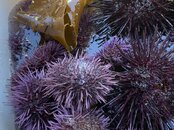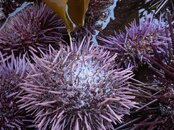That device looks pretty cool, a little complex and techy but cool none the less.
I still think removal by hand is probably quicker and easier.
We are allowed to harvest 40 gallons of purple urchins per day in the purple urchin problem counties. There is no possession limit.
There are only two sites that are designated as culling zones, one is Caspar Cove in Mendocino County and the other is Tankers Reef in Monterey County.
I can remove 40 gallons of purple urchins in less than a few hours and I can do it a lot of times on one tank of air (three shallow dives). I have the biggest green game bag that Trident makes and I stuff it full three times which works out to be 40 gallons of whole urchins.
I use a 50# lift bag to suspend the collection bag once it begins to fill to make it easier to float around. I put just enough air in the lift bag to make the urchin bag neutral. I estimate that 40 gallons if urchins is somewhere between 800 and 1200 individual animals.
I use an old ab iron to knock a few stubborn urchins loose that have locked down on rocks. Most of them are easy enough to just handle carefully with kevlar gloves and get them into the game bag. It is very quick work to fill a bag (15 to 20 minutes, and that is a very large bag, much larger than the one shown on the urchin vacuum machine.
Most of my work is in 8-10’ of water right off the beach. I have been concentrating on Stillwater Cove in Sonoma County as my pet project area. All my efforts are concentrated there. I’m seeing a lot of small abalone coming back along the interface between the kelp weed line close to the beach and the barrens a little farther out. I work from this urchin free interface zone outward in an effort to increase the area out from the beach where the abalone can feed and be urchin free. My fear is that with the pending winter storm season looming that the abalone will be dislodged from the shallow beach zone by large swells and flung onto the beach during large winter storms, since that’s where all of them seem to be thriving.
It is critical that we do everything in our power to try and get this problem under control. Like the article says, healthy kelp is critical to a lot more than just abalone and fish, it affects CO2 levels in the atmophere also.
We need to clear urchins!!
I have plans to attend several DFW public meetings to try and introduce at least three new motions regarding purple urchins. One would be to remove or suspend the 40 gallon limit and change it to no limit take. The second would be to suspend the general wanton waste clause specific to purple urchins and have that in writing, and the third would be to suggest enacting a cash bounty for purple urchins based on poundage. The price paid would have to be determined and a collection and weigh station would have to be created.
Perhaps a good place to spend some of that state budget surplus?
I have been trying to get people involved in purple urchin removal for months even years. So far I’ve very little success. People seem to be more interested in their own pleasures and don’t want to be bothered by doing work dives. It’s a little frustrating to say the least. Trying to get divers together as a team to do this is like herding cats

I’m going to continue to try and recruit divers for this project. I’m going to talk to Seal’s Water Sports in Santa Rosa and see if they would be willing to put up a special purple urchin removal information page on their website with info about where-when-how and have sales on urchin removal gear like large green game bags, lift bags, bars, clips, etc.
I’m also going to continue to post here in an attempt to get people interested and fired up.
I sincerely hope many of you take this problem a little more seriously, this is an important and noble cause.
Please get involved.





